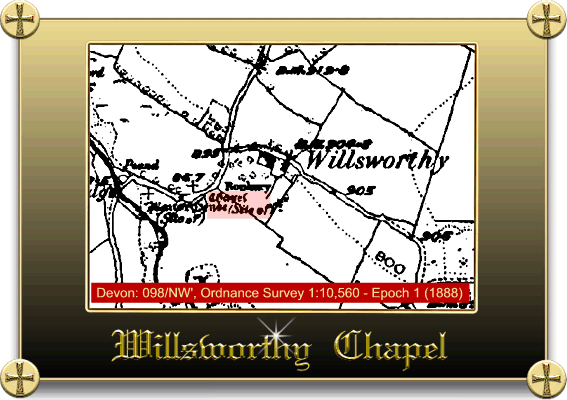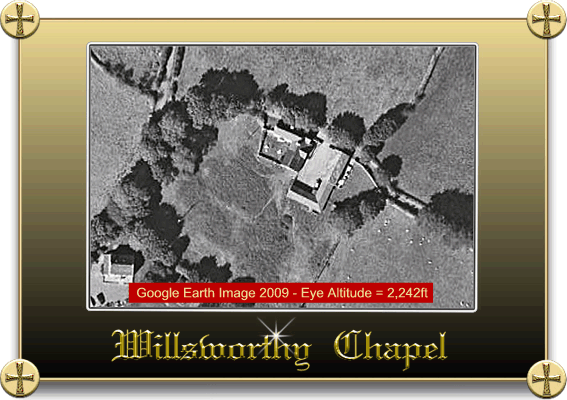
He was on his way to Willsworthy, four miles from the parish church, at the extreme end of the parish, to pay a pastoral visit to Mistress Malvine, who was an invalid. Before reaching the house he came to a ruined chapel, that had not been used since the Reformation..’, Baring Gould, 1891, p.71.
Although the above extract comes from a novel of Baring Gould’s he was noted for including a fair bit of historical fact amongst his fiction and from the above it could be suggested that there was a chapel at Willsworthy that hadn’t been used since the reformation (16th Century). There can be no doubt that there was once a chapel at Willsworthy but the million dollar question is – where was it. Under the entry for Peter Tavy, Lyson makes the following comment: ‘There is a chapel at Wilsworthy,, which has been converted into a cow-house.‘ 1822, p.477.
From this research has shown that the Archaeology Data Service list this building as being medieval in date. Pevsner states that ‘A window with trefoiled head in an outbuilding may come from the chapel of the former’s manor.’ 1952, p.627. Hemery also notes the existence of this window and more crucially adds that it belongs to; “a chapel-of-rest and hostel, and the only one for bearers and deceased on this long, arduous route (the Lych Way),” 1986, p. 237. He does in his later book contradict this statement somewhat when he notes, ‘the actual site of the Domesday manor and chapel of ‘Wilfleurde’ (sic) is probably nearer Lower Willsworthy Farm and this ecclesiastical relic may have been inserted in the barn, perhaps during Tudor times, to provide ventilation for the hayloft’. 1986, p.947. However both the OS map of 1860 and the NMR co-ordinates do in fact place the remains of the chapel at Lower Willsworthy as Hemery later suggested – see map below:

Further possible evidence for the location of the medieval chapel of ease can be seen when looking at an aerial photograph of the area. The modern property is now known as Higher Willsworthy and it appears that there is a distinct rectilinear feature in the field adjacent the main house – see photograph below.

The early window is located in the barn which is opposite the farmhouse. This would mean that it never had to travel very far from the old site of the chapel to its new location. In 2005 a local field investigator from English Heritage paid a visit after which they noted the following: ‘In Higher Willsworthy Farm, high up in the north west wall of the large barn is a small decorated window of stone, which most certainly looks of ecclesiastical origin and bears two holes at either side which may at one time have been bar sockets.’ In a similar vane British Listed Building state the following about the Grade II listed barn; “Below the eaves to the left is a small medieval stone trefoiled light reputed to have come from the site of a nearby medieval chapel.” However, it is possible that the window came from a different source and was incorporated in the original structure as some kind of ornament? An excellent photograph of the window can be seen on Jonnie’s Meanderings website – HERE.
This chapel would have been used by the inhabitants of Willsworthy as it is known that in 1384 Master David of Bagatorre was the vicar of Tavistock and by the very fact that he is documented as being at Bagtor would suggest that the chapel was for his private use. But it may well have also offered a place where funeral processions travelling along the Lych Way could have stopped for some respite after their arduous moorland trek. There can be no question that the chapel lay on the old corpse roads’ route as tradition dictates that it went through nearby Coffin Wood and was approached by Corpse Lane. The existence of such a chapel does question the tradition of Coffin Wood because why should any funeral procession want to halt at a wood when a chapel was so close?

Baring Gould, S. 1891. Urith – A Tale of Dartmoor, London: Methuen & Co.
Hemery, E. 1986. Walking Dartmoor’s Ancient Tracks. London: Robert Hale Publishing.
Hemery, E. 1983. High Dartmoor. London: Robert Hale Publishing.
Lyson, D. & Lyson, S. 1822. Magna Britannia – Devonshire, London: Thomas Cadell.
Pevsner, N. 2004. The Buildings of England – South Devon, London: Yale University.
 Legendary Dartmoor The many aspects past and present of Dartmoor
Legendary Dartmoor The many aspects past and present of Dartmoor
